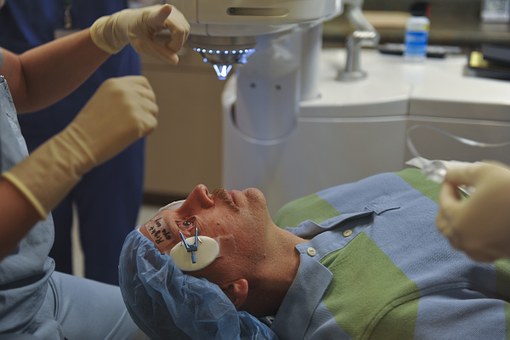Infective keratitis (IK) is one of the world's leading causes of visual impairment and blindness. The causative microorganisms of IK include bacteria, fungi and protozoa and treatment is often empirical until the aetiological agent is identified. However, delayed initiation of appropriate antimicrobial therapy can lead to decreased vision up to 30%. In addition, resistance to some of the antimicrobials used in clinical routine, the limited availability of drugs and the ocular toxicity of some of these, when administered over a long period, can complicate treatment regimes for different types of keratitis.
Corneal cross-linking (CXL) can be an effective intervention for patients with infectious corneal ulcers as it is able to reduce inflammation and inactivate the causative agent of infection at the same time. CXL is currently used as a treatment for corneal ectasia disorders such as keratoconus and post-LASIK ectasia as it has proven to be a targeted intervention to stabilise and maintain the shape of the cornea.
Why Corneal Cross-Linking in the Treatment of Infectious Keratitis?
Studies in vitro have shown that photoactivation of riboflavin by UV light irradiation causes the release of reactive oxygen species which, in turn, promote the formation of covalent bonds between adjacent collagen molecules. This process can, in this way, strengthen the cornea, increase the corneal tissue's resistance to enzymatic degradation and reduce the risk of perforation, a complication of infective keratitis. In addition, reactive oxygen species have an antiseptic effect against a broad spectrum of pathogens.
To date, although three randomised controlled trials have been conducted on a small sample size to evaluate the effect of corneal cross-linking in the treatment of infective keratitis, the limitations of these clinical studies and some conflicting results still do not support the use of this technique. In this paper, the authors, by means of a survey, evaluated the most common clinical practices and the opinions of corneal experts regarding CXL for IK.
Indications and clinical practice
The results of the survey, which was sent to 190 recipients, showed that the majority of respondents (66%) had already used corneal cross-linking to treat IK with both established infectious cause and unknown aetiology. The main indications for the use of CXL as adjuvant therapy of IK were: i) worsening of the diameter or depth of the corneal infiltrate despite therapy (74%); ii) antibiotic resistance (68%); iii) corneal thinning (53%); iv) poor patient compliance with therapy (26%); v) other reasons (21%).
Of the respondents who believed corneal cross-linking could be useful for treating infectious keratitis, 54% stated that there is no ideal ulcer position to maximise the benefits of such an intervention, while only 25% believed that a central ulcer position would benefit most from CXL. Furthermore, most of the Experts believe that CXL may be useful for infections with small (71%) and/or medium-sized infiltrate diameters (70%). When asked when CXL should ideally be performed after the onset of infectious keratitis, 46% of the Experts reported <1 week after ulcer onset, 38% reported 1-4 weeks after onset. 84% of the Experts reported that the main benefit of corneal cross-linking for IK would be microbial eradication, at the same time 60% of the respondents reported that CXL would also be beneficial in preventing corneal thinning. In particular, the data from this survey suggest that corneal cross-linking is moderately useful as adjuvant or sole therapy for bacterial or fungal keratitis, followed by Acanthamoeba keratitis.
Costs
Cornea specialists were also asked about the proportion of their patients who, in their opinion, would not be able to undergo CXL for IK because of the cost. The data in this regard are mixed, as slightly more than half of the respondents (56%) reported that CXL is not cost prohibitive for any of their patients, while a quarter of the respondents reported that about 50% of their patients would not be able to afford the expense of the corneal cross-linking procedure.
Limits and perspectives for the future
Corneal specialists who have used CXL agree that this procedure could be useful in the treatment of small to medium-sized bacterial ulcers. However, the majority of the Experts remain uncertain about the efficacy of CXL on fungal and protozoal keratitis. Furthermore, a quarter of the respondents reported that a moderate percentage of their patients would not be able to undergo corneal cross-linking because of the costs. Thus, although these preliminary data are very interesting, this survey suggests that larger randomised controlled trials are needed to evaluate the efficacy of CXL as monotherapy or adjuvant therapy for IK.
Sources
Hsia YC et al. Expert practice patterns and opinions on corneal cross-linking for infectious keratitis. BMJ Open Ophthalmol. 2018 Mar 16;3(1):e000112. doi: 10.1136/bmjophth-2017-000112. eCollection 2018.
Dr. Carmelo Chines
Direttore responsabile

